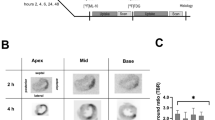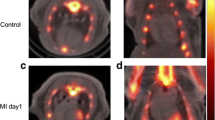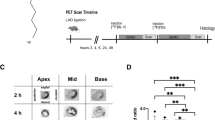Abstract
Background
We aimed to explore how the severity of myocardial ischemia affects myocardial sigma-1 receptor (Sig-1R) expression using 125I-labeled 2-[4-(2-iodophenyl)piperidino]cyclopentanol (125I-OI5V) imaging.
Methods and results
The left coronary artery was occluded for 30, 20, and 10 minute, to vary the severity of myocardial ischemia, followed by reperfusion. Dual-tracer autoradiography of the left ventricular short-axis slices was performed 3 and 7 days after reperfusion. 125I-OI5V was injected 30 minute before sacrifice and the area at risk (AAR) was evaluated by 99mTc-MIBI. Intense 125I-OI5V uptake was observed in the AAR and was significantly increased with increasing ischemia duration. To evaluate salvaged and nonsalvaged areas (preserved and decreased perfusion areas), triple-tracer autoradiography was performed 3 days after reperfusion. After dual-tracer autoradiography, 201Tl was injected 20 minute post 125I-OI5V injection. On triple-tracer autoradiography, the AAR/normally perfused area 125I-OI5V uptake ratio was positively correlated with the nonsalvaged area/whole left ventricular (LV) area ratio (P < .05). The AAR/normally perfused area 125I-OI5V uptake ratio was negatively correlated with the 201Tl uptake ratio of the AAR to normally perfused areas (P < .05). The comparison of the immunostaining distribution of 125I-OI5V and the macrophage marker CD68 revealed that 125I-OI5V was present mainly in, and immediately adjacent to the macrophage infiltration area.
Conclusions
Significant 125I-OI5V uptake in the AAR depends on the duration of ischemia and reduced 201Tl uptake; furthermore, 125I-OI5V was found in and around the macrophage infiltrate area. These results indicate that iodine-labeled OI5V is a promising tool for visualizing Sig-1R expression according to the ischemic burden.






Similar content being viewed by others
Abbreviations
- AAR:
-
Area at risk
- CD68:
-
Cluster of differentiation 68
- DAPI:
-
4′,6-Diamidino-2-phenylindole
- ER:
-
Endoplasmic reticulum
- LCA:
-
Left coronary artery
- LV:
-
Left ventricular
- OI5V:
-
2-[4-(2-Iodophenyl)piperidino]cyclopentanol
- ROI:
-
Region of interest
- Sig-1R:
-
Sigma-1 receptor
- 99mTc-MIBI:
-
99mTc-hexakis 2-methoxyisobutyl isonitrile
References
Shigeno T, Kozaka T, Kitamura Y, Ogawa K, Taki J, Kinuya S. In vitro and in vivo evaluation of [(125/123)I]-2-[4-(2-iodophenyl)piperidino]cyclopentanol([(125/123)I]-OI5V) as a potential sigma-1 receptor ligand for SPECT. Ann Nucl Med 2021;35:167‐75.
Stracina T, Novakova M. Cardiac sigma receptors: An update. Physiol Res 2018;67:S561‐76.
Su TP, Su TC, Nakamura Y, Tsai SY. The sigma-1 receptor as a pluripotent modulator in living systems. Trends Pharmacol Sci 2016;37:262‐78.
Penke B, Fulop L, Szucs M, Frecska E. The role of sigma-1 receptor, an intracellular chaperone in neurodegenerative diseases. Curr Neuropharmacol 2018;16:97‐116.
Vilner BJ, John CS, Bowen WD. Sigma-1 and sigma-2 receptors are expressed in a wide variety of human and rodent tumor cell lines. Cancer Res 1995;55:408‐13.
Tagashira H, Bhuiyan S, Shioda N, Hasegawa H, Kanai H, Fukunaga K. Sigma1-receptor stimulation with fluvoxamine ameliorates transverse aortic constriction-induced myocardial hypertrophy and dysfunction in mice. Am J Physiol Heart Circ Physiol 2010;299:H1535‐45.
Wakabayashi H, Taki J, Mori H, Hiromasa T, Akatani N, Inaki A, et al. Visualization of dynamic expression of myocardial sigma-1 receptor after myocardial ischemia and reperfusion using radioiodine-labeled 2-[4-(2-iodophenyl)piperidino]cyclopentanol (OI5V) imaging. Circ J 2021;85:2102‐8.
Lewis R, Li J, McCormick PJ, Christoper LHH, Jeevaratnam K. Is the sigma-1 receptor a potential pharmacological target for cardiac pathologies? A systematic review. Int J Cardiol Heart Vasc 2020;26:100449.
Ela C, Barg J, Vogel Z, Hasin Y, Eilam Y. Sigma receptor ligands modulate contractility, Ca++ influx and beating rate in cultured cardiac myocytes. J Pharmacol Exp Ther 1994;269:1300‐9.
Novakova M, Ela C, Barg J, Vogel Z, Hasin Y, Eilam Y. Inotropic action of sigma receptor ligands in isolated cardiac myocytes from adult rats. Eur J Pharmacol 1995;286:19‐30.
Taki J, Higuchi T, Kawashima A, Tait JF, Muramori A, Matsunari I, et al. (99m)Tc-Annexin-V uptake in a rat model of variable ischemic severity and reperfusion time. Circ J 2007;71:1141‐6.
Wakabayashi H, Taki J, Inaki A, Shiba K, Matsunari I, Kinuya S. Correlation between apoptosis and left ventricular remodeling in subacute phase of myocardial ischemia and reperfusion. EJNMMI Res 2015;5:72.
Taki J, Wakabayashi H, Inaki A, Imanaka-Yoshida K, Hiroe M, Ogawa K, et al. 14C-Methionine uptake as a potential marker of inflammatory processes after myocardial ischemia and reperfusion. J Nucl Med 2013;54:431‐6.
Tarone G, Brancaccio M. Keep your heart in shape: Molecular chaperone networks for treating heart disease. Cardiovasc Res 2014;102:346‐61.
Taki J, Higuchi T, Kawashima A, Tait JF, Kinuya S, Muramori A, et al. Detection of cardiomyocyte death in a rat model of ischemia and reperfusion using Tc-99m-labeled annexin V. J Nucl Med 2004;45:1536‐41.
Taki J, Inaki A, Wakabayashi H, Imanaka-Yoshida K, Ogawa K, Hiroe M, et al. Dynamic expression of tenascin-C after myocardial ischemia and reperfusion: Assessment by 125I-anti-tenascin-C antibody imaging. J Nucl Med 2010;51:1116‐22.
Blankesteijn WM, Creemers E, Lutgens E, Cleutjens JP, Daemen MJ, Smits JF. Dynamics of cardiac wound healing following myocardial infarction: Observations in genetically altered mice. Acta Physiol Scand 2001;173:75‐82.
Lambert JM, Lopez EF, Lindsey ML. Macrophage roles following myocardial infarction. Int J Cardiol 2008;130:147‐58.
Ruiz-Cantero MC, Gonzalez-Cano R, Tejada MA, Santos-Caballero M, Perazzoli G, Nieto FR, et al. Sigma-1 receptor: A drug target for the modulation of neuroimmune and neuroglial interactions during chronic pain. Pharmacol Res 2021;163:105339.
Bravo-Caparros I, Ruiz-Cantero MC, Perazzoli G, Cronin SJF, Vela JM, Hamed MF, et al. Sigma-1 receptors control neuropathic pain and macrophage infiltration into the dorsal root ganglion after peripheral nerve injury. FASEB J 2020;34:5951‐66.
Scholz J, Woolf CJ. The neuropathic pain triad: Neurons, immune cells and glia. Nat Neurosci 2007;10:1361‐8.
Disclosures
The authors declare that they have no conflict of interest.
Ethical approval
All experiments were approved by the Institute for Animal Studies of Kanazawa University (AP-173846). All applicable Japanese and institutional guidelines for the care and use of animals were followed.
Author information
Authors and Affiliations
Corresponding author
Additional information
Publisher's Note
Springer Nature remains neutral with regard to jurisdictional claims in published maps and institutional affiliations.
Funding
This work has been supported by the Japan Society for the Promotion of Science (JSPS) KAKENHI Grant Number JP20K08047.
The authors of this article have provided a PowerPoint file, available for download at SpringerLink, which summarises the contents of the paper and is free for re-use at meetings and presentations. Search for the article DOI on SpringerLink.com.
All editorial decisions for this article, including selection of reviewers and the final decision, were made by guest editor Stephan Nekolla, MD.
Supplementary Information
Below is the link to the electronic supplementary material.
Rights and permissions
About this article
Cite this article
Wakabayashi, H., Mori, H., Hiromasa, T. et al. 125I-labeled 2-[4-(2-iodophenyl)piperidino]cyclopentanol (125I-OI5V) imaging visualized augmented sigma-1 receptor expression according to the severity of myocardial ischemia. J. Nucl. Cardiol. 30, 653–661 (2023). https://doi.org/10.1007/s12350-022-03064-8
Received:
Accepted:
Published:
Issue Date:
DOI: https://doi.org/10.1007/s12350-022-03064-8




